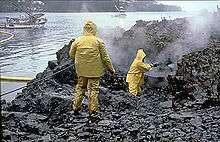Supply chain sustainability
Supply chain sustainability is a business issue affecting an organization’s supply chain or logistics network in terms of environmental, risk, and waste costs. There is a growing need for integrating environmentally sound choices into supply-chain management.[1] Sustainability in the supply chain is increasingly seen among high-level executives as essential to delivering long-term profitability and has replaced monetary cost, value, and speed as the dominant topic of discussion among purchasing and supply professionals.A sustainable supply chain seizes value creation opportunities and offers significant competitive advantages for early adopters and process innovators.[2]
Background
Supply chains are critical links that connect an organization’s inputs to its outputs. Traditional challenges have included lowering costs, ensuring just-in-time delivery, and shrinking transportation times to allow better reaction to business challenges. However, the increasing environmental costs of these networks and growing consumer pressure for eco-friendly products has led many organizations to look at supply chain sustainability as a new measure of profitable logistics management.[3] This shift is reflected by an understanding that sustainable supply chains frequently mean profitable supply chains.[4]
Many companies are limited to measuring the sustainability of their own business operations and are unable to extend this evaluation to their suppliers and customers. This makes determining their true environmental costs highly challenging and reduces their ability to remove waste from the supply chains. However much progress has been made in defining supply chain sustainability and benchmarking tools are now available that enable sustainability action plans to be developed and implemented.[5]
One of the key requirements of successful sustainable supply chains is collaboration. The practice of collaboration — such as sharing distribution to reduce waste by ensuring that half-empty vehicles do not get sent out and that deliveries to the same address are on the same truck — is not widespread because many companies fear a loss of commercial control by working with others. Investment in alternative modes of transportation — such as use of canals and airships — can play an important role in helping companies reduce the cost and environmental impact of their deliveries.[6] Collaboration platforms are emerging because of the fear of a loss of commercial control and competitive advantage by working closely with other companies.[7]
Three Tiers of Sustainability
In 2008, The Future Laboratory produced a ranking system for the different levels of sustainability being achieved by organization. This was called the Three Tiers of Sustainability:
Tier 1: Getting the basics right
This is the base level and is the stage in which the majority of organizations are at. Companies employ simple measures such as switching lights and PCs off when left idle, recycling paper, and using greener forms of travel with the purpose of reducing the day-to-day carbon footprint. Some companies also employ self-service technologies such as centralized procurement and teleconferencing.
Tier 2: Learning to think sustainably
This is the second level, where companies begin to realize the need to embed sustainability into supply chain operations. Companies tend to achieve this level when they assess their impact across a local range of operations. In terms of the supply chain, this could involve supplier management, product design, manufacturing rationalization, and distribution optimization.
Tier 3: The science of sustainability
The third tier of supply chain sustainability uses auditing and benchmarks to provide a framework for governing sustainable supply chain operations. This gives clarity around the environmental impact of adjustments to supply chain agility, flexibility, and cost in the supply chain network.[8] Moving towards this level means being driven by the current climate (in which companies recognize cost savings through green operations as being significant) as well as pushing emerging regulations and standards at both an industry and governmental level.
Application of Sustainability
Companies looking to implement sustainable strategies down its supply chain should also look upstream. To elaborate, if a company is able to choose between various suppliers, it can for example use its purchasing power to get its suppliers in compliance with its green supply chain standards. In managing suppliers, companies must measure that inputs from suppliers are of high quality, and the usage of water and energy is minimised leading to less pollution, defects and over production. They also must audit their supplier base and make sure that they are improving the supply chain metrics[9]
Software
As supply chain sustainability becomes a more critical business issue, the need for reliable and robust data from suppliers increases. Whilst some existing business systems can collect some sustainability data, most large businesses will look to dedicated software providers for more specific sustainability functionality.
References
- ↑ Srivastava, Samir K "Green Supply Chain Management: A state-of-the-art Literature Review", International Journal of Management Reviews, 2007, 9(1), 53-80.
- ↑ Srivastava, Samir K, "Sustainable Supply Chain Management: Doing The Right Thing", Logistics Times, 1(8), December 2010, pp. 19-23 (Available at: http://issuu.com/rajmisra/docs/lt_december_2010/19?mode=a_p Accessed on October 12, 2014).
- ↑ Supply Chain Management
- ↑ The Sustainable Supply Chain Project
- ↑ Weir Total Supply Chain Sustainbility
- ↑ Airships float back to the futures
- ↑ "Supply Chain Sustainability: A Strategic Responsibility". Procurious. Lucy Harding. Retrieved 20 May 2016.
- ↑ The Science of Sustainability, pg 14
- ↑ Kumar, Sameer; Teichman, Steve; Timpernagel, Tobias."A green supply chain is a requirement for profitability" International Journal of Production Research, Mar2012, Vol. 50 Issue 5, p1278-1296,
| Look up supply chain sustainability in Wiktionary, the free dictionary. |
